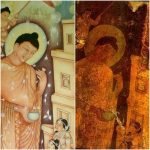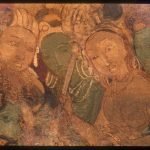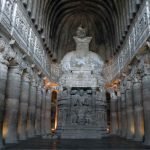Foreign Minister of China Mr Wang Yi with a portrait from Ajanta Monastery presented by late Mr M.R Pimpare (media image)
Various artists and art historians across the globe have spent their lifetimes documenting Ajanta Caves, through their own interpretations, guided by their knowledge, spirituality and historical understanding. Various countries of the world including China regard paintings on the Ajanta Caves as being extremely critical to their existence and origin.
Both India and China preserve ancient Buddhist grottoes, or caves, demonstrating the deep history of China-India cultural exchanges and representing different Eastern philosophical modes of thought. Cultural exchanges between China and India go back thousands of years. One of the most influential is the introduction of Buddhism to China from India, which forms a key cultural tie between the two countries. Both India and China preserve ancient Buddhist grottoes, or caves, demonstrating the deep history of China-India cultural exchanges. China and India share abundant similarities in culture, representing different Eastern philosophical modes of thought.
Ajanta Caves is the symbol of this history and is also the key to the modern culture of China. Watch this space for more articles on the significance of Ajanta Caves in China.
















Add Comment